The most torque you will find from a cordless impact ratchet is the Milwaukee fuel line with 60 ft-lbs of advertised torque. They offer a 1/4″, 3/8″, and a 1/2″ Fuel Ratchet that has more torque than Harbor Freight, Snap-On, or Husky in the same drive size. The Milwaukee 1/2″ can do around 60 ft-lbs of torque, the Harbor freight claims to do 60 ft-lbs (it can’t), and the Snap-On does only 35 ft-lbs. Now that we have that out of the way, I am going to go through the important qualities to look at when choosing a cordless ratchet. In this article, we will analyze the versatility of the tool, warranty, battery life, RPMs, and price. You will find out what cordless impact ratchet is the best bang for your money, hands down.
Let me preface this to say this is based on my experience having used many different impacts ratchets and having done a lot of research on the subject. I am sure there are people that will disagree with my conclusions.
Even the test used to determine torque values can be flawed or cheated by the different manufacturers. They can figure out the optimal settings to test their torque ratchet and get the highest numbers possible, but in real-life use, you will never recreate their torque values. An advertised 60 ft-lbs of torque on a cordless ratchet may actually be more like 30 ft-lbs real worlds.
Table of Contents
Torque Ratings = Marketing Gimmicks:
Most people constantly talk about torque ratings with cordless tools. How many ft-lbs of breakaway torque does the Milwaukee fuel ratchet have vs. the non-fuel version?
Does the Snap-On have more breakaway torque than the Milwaukee ratchet, or is the Harbor Freight actually the strongest?
I am going to tell you a little secret when it comes to the torque ratings on cordless battery powered ratchets. Torque ratings on impact ratchets are one of the last things you should consider as a buyer. This only applies to impact ratchets, it is a totally different story when we are talking about Milwaukee vs. Dewalt 1/2″ impact wrenches torque values. That is a tool made for breaking really tight things loose, an impact wrench, however, is made to help you remove fasteners in tight spaces fast and easy.
Confused on the difference between an impact wrench and an impact ratchet?
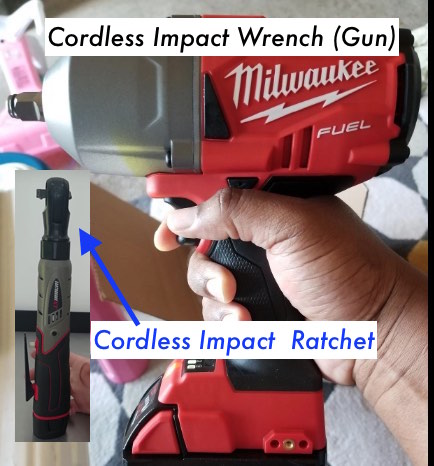
Why are these torque ratings pointless?
Because cordless impact ratchets are not made for high torque applications. They are time-saving devices that fit in tight spaces and allow you to back off a long bolt quickly and easily. You can use them just like a normal ratchet and break the fastener loose first by hand then use the electric feature to back it all the way out.
I have used the Snap-On version, the Milwaukee version, Husky cordless ratchet, and the Harbor Freight ratchet.
What are the first things that come to mind when I pick them up and use them?
Their weight, length, RPM’s for removal, price, warranty, and battery life. What isn’t a deciding factor when thinking about which one is my favorite? Whether or not the advertised torque values are accurate or not, and whether or not they will remove a 60 ft-lb fastener (spoiler– they don’t).
Harbor Freight is Blowing Smoke:
Yes, and I don’t like it as much as you probably don’t like being cheated. That is the issue with marketing in 2019, there are so much fluff and junk on the boxes. The Harbor Freight Earthquake EQ38RXT-12V 3/8″ cordless ratchet wrench says it can do 60 ft-lbs in huge letters on the box. They also call it the “Xtreme” torque model.
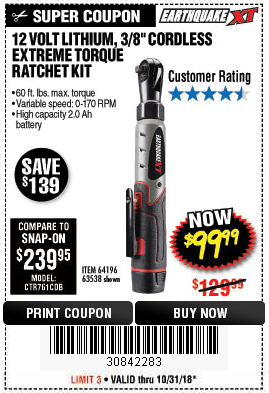
We are already seeing that trend happen in cordless ratchets and the backlash from customers that are expressing their concern. It seems manufacturers only care about hitting their marketing numbers and marketing towards uninformed buyers. So, as long as the ratchet that has the highest torque ratings is still selling the most– companies are going to try to have the highest torque numbers.
For real-world torque values, I would say the Harbor Freight 3/8″ ratchet probably does around 30-40ft-lbs routinely. That number changes depending on the fastener, type of socket, rust, etc.
Anything in the 20-40 ft-lb range for a torque ratchet is totally sufficient. The beauty of these tools is that you can use them as a normal ratchet and break the fastener loose before engaging the electric motor to back it out quickly.
What I do notice compared to the Snap-On or the Milwaukee ratchet is that the harbor freight is SLOWER (RPM wise). Meaning it takes longer to back off the fastener. That is much more important than whether or not you have to put in a tiny bit of elbow grease to break the fastener loose first.
Torque #’s Sucks RPM’s Matter
So, what are the important features to look at when you are buying a cordless impact ratchet?
- Price (Harbor Freight Cheapest/Milwaukee best value)
- Battery Platform Compatibility (Milwaukee wins by far)
- Rotations Per Minute (1. Snap On 2. Milwaukee 3. Harbor Freight)
- Warranty (Milwaukee 5 years clear winner)
- Battery Life (All last a long time, Snap-On is fastest and therefore dies the soonest during full use)
- Light or No Light (Milwaukee has light, Snap-On does, Habor Freight no).
- Battery Charge Indicator or Not (Milwaukee/Snap-On have charge indicator, Harbor Freight does not)
- Versatility (Snap-On long neck cordless is clear winner, Milwaukee Non-Fuel also)
- Breakaway Torque (1. Milwaukee Fuel 2. Snap-On 3. Harbor Freight– I think it is a POINTLESS number).
If all you care about in a cordless ratchet is breakaway torque then just go buy the Milwaukee Fuel 3/8″ or 1/2″ Milwaukee Fuel Ratchet here
. They are great tools with an awesome warranty and beat the Snap-On and the Harbor Freight in actual breakaway torque values.
The only drawback to the Milwaukee Fuel impact ratchets is that they are bulkier than the non-fuel impact ratchets. For me, one of the most important things is that my impact ratchets can fit in tight spaces easily. I do NOT want a bulky head on my impact ratchet.
However, I would say the actual better cordless ratchet isn’t the Milwaukee Fuel versions (they are larger and bulkier) but the Non-Fuel Milwaukee cordless ratchets.
Blasphemy. How could I? Milwaukee Fuel isn’t better than the non-fuel? What am I paying for then?
Sorry if this offends you. I understand if you are paying more for a tool you should expect it is a better tool. Milwaukee fuel is the professional line of tools and they cost more than the non-fuel versions. Shouldn’t this mean they are always better?
Milwaukee Fuel ratchets are very nice– but, can be quite bulky for certain uses. If you don’t have the budget to own both the Fuel and the non-fuel versions of their ratchets– then I highly recommend just sticking with the non-fuel (cheaper) Milwaukee cordless ratchets.
They are smaller, fit in tighter spots, and you can still break bolts loose first with the manual ratchet function (you just use it as a normal socket wrench).
For me, that is the entire point of the cordless ratchets in the first place. To make removal of bolts much less tedious and cause you much less strain and stress than if you did it by hand. I almost NEVER put a cordless ratchet on a fastener and hit the trigger right away without breaking it loose by hand first. Ok, not with an 8mm or 10mm fastener, but any of these cordless ratchets will remove those fasteners.
Let’s take a look at some of the statistics that I think actually matter when choosing what cordless ratchet to buy.
Who Makes The Best Cordless Impact Ratchet:
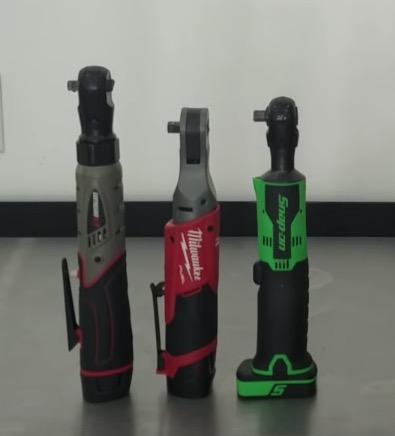
TL: DR the Milwaukee non-fuel ratchets are the best bang for your buck when you include all the important features. The warranty on Milwaukee’s ratchets is miles ahead of any other brand (5 years on the tool). You also aren’t paying an arm and a leg like the Snap-On 14.4v ratchets, and are getting a step up in quality from the Harbor Freight version. For those of you that want to see all the little details and numbers for each of the brands keep reading.
Cordless Impact Ratchet Specifications
1. Roughly around $170 for the tool only in 2019.
2. Advertised as 55 ft-lbs of torque.
3. 5-year warranty (easy process)
4. Lots of battery options
5. LED light in the tool
6. Battery Indicator
6. Brushless motor
7. 200 RPM
8. Available at many different home improvement stores, online, used etc.
9. Warranty is based on Serial Number and age. No receipt needed (you can buy used and still warranty it online)
(Price roughly $170 for an entire kit– tool, charger, and battery)
1. 35 ft. lbs. of torque
2. 250 RPM
3. 5 Year Warranty
4. Brushed Motor
5. LED Light– one of those features you don’t realize is actually super useful and nice to have
6. Battery Indicator (another feature that will save you a headache from a tool dying mid-job)
7. More versatile and smaller than the Fuel 3/8″ version.
8. Faster 250 RPM than the Fuel version’s 200 RPMs (50 rpm’s more) meaning it removes fasteners 20% faster than the fuel version.
9. MY FAVORITE of them all. Shop for them on Amazon here.
You can pick up the tool only for like $65 brand new.
1. Price is the highest at around $250/460 for a tool-only or a “kit (battery and charger included)”
2. 35 ft-lbs of torque
3. 2nd worst warranty with a 1-year tool warranty.
4. FASTEST RPM 350 free spinning RPM’s
5. 1-year warranty on the battery
6. Good tool, but not worth the money.
7. They do make a long neck version of the same ratchet that is an absolutely killer design (check it out here)
1. Only a 90-day warranty
2. Comes with a battery and charger
3. Works perfectly well, but is misleading in its torque marketing (it cannot do 60 ft-lbs in real-world automotive use)
4. Is pretty long and heavy (can be a good thing and a bad thing)
5. Advertised 60-ft-lbs of torque.
6. SLOWEST RPM 170 MAX
7. No LED
8. No Battery Indicator on Tool
9. Not a lot of tools that use the same battery platform
10. Brushed Motor
11. Sparks a lot when using– do not use around fuel vapors.
Overall a decent budget buy, but you really should just be buying the Milwaukee non-fuel you will be much happier!
$80 for the tool which has a built-in battery
1. 2-year warranty
2. 35-ft lbs of torque (probably real world a bit less)
3. 230 RPM’s
4. Works great but has no ability to swap out batteries when it dies it dies (battery is built in).
Click here to check out the reviews on Amazon. You can get a better price at Home Depot
Winner: Milwaukee Cordless Ratchets
You don’t have to be a genius to see the Milwaukee clearly offers the best value when you include the warranty. Snap-On is crazy expensive and only has a one year warranty. Plus many professional technicians complain about long wait times to get their cordless tools back from Snap-On. Also, you may associate Snap-On with made in the USA, but you would be wrong with their cordless tools they are imported just like Milwaukee’s and everyone else’s.
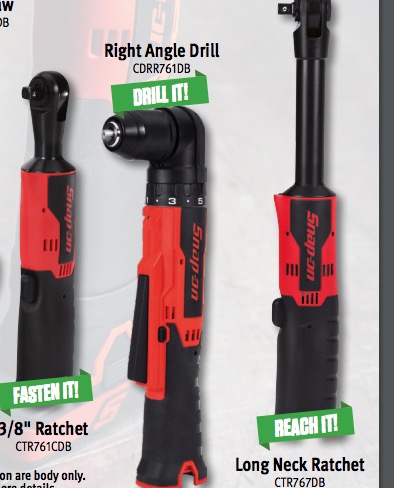
The only reason to be buying the Snap-On cordless ratchets is to buy the long-neck version that will literally become your favorite tool if you own it. Otherwise, stick with the Milwaukee m12 ratchet lineup (80+ tools on the same battery) and you will be more than happy.
If strictly purchasing on the tightest budget and you want the best cordless ratchet for the least amount of money– get the Husky 3/8″ at Home Depot or the Harbor Freight ratchet and make sure to search for a coupon first. Both work perfectly well but aren’t professional grade to stand-up to the Milwaukee or the Snap-On.

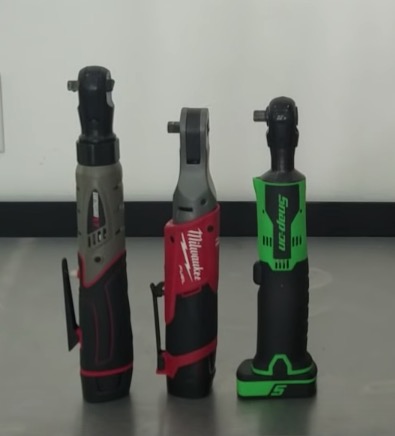




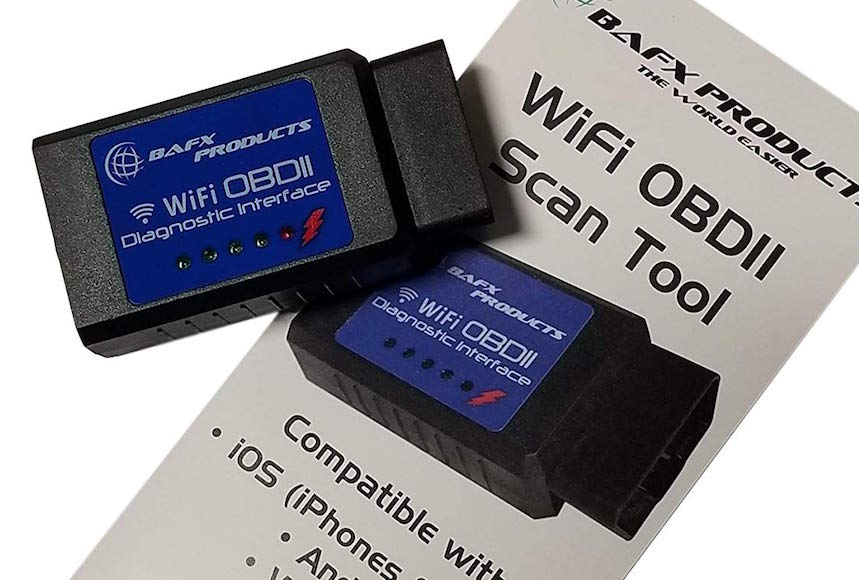
The author keeps saying that the torque rating doesn’t matter, but they’re wrong. I’ve used both high speed and high torque electric ratchets and the ability to remove a bolt that has a fair amount of drag on it for the whole length definitely trumps being able to run bolts in and out quickly. In either situation you are still doing very little work, unless you have to remove the stiff bolt completely by hand because your ratchet isn’t strong enough. Other than that it’s a good review.